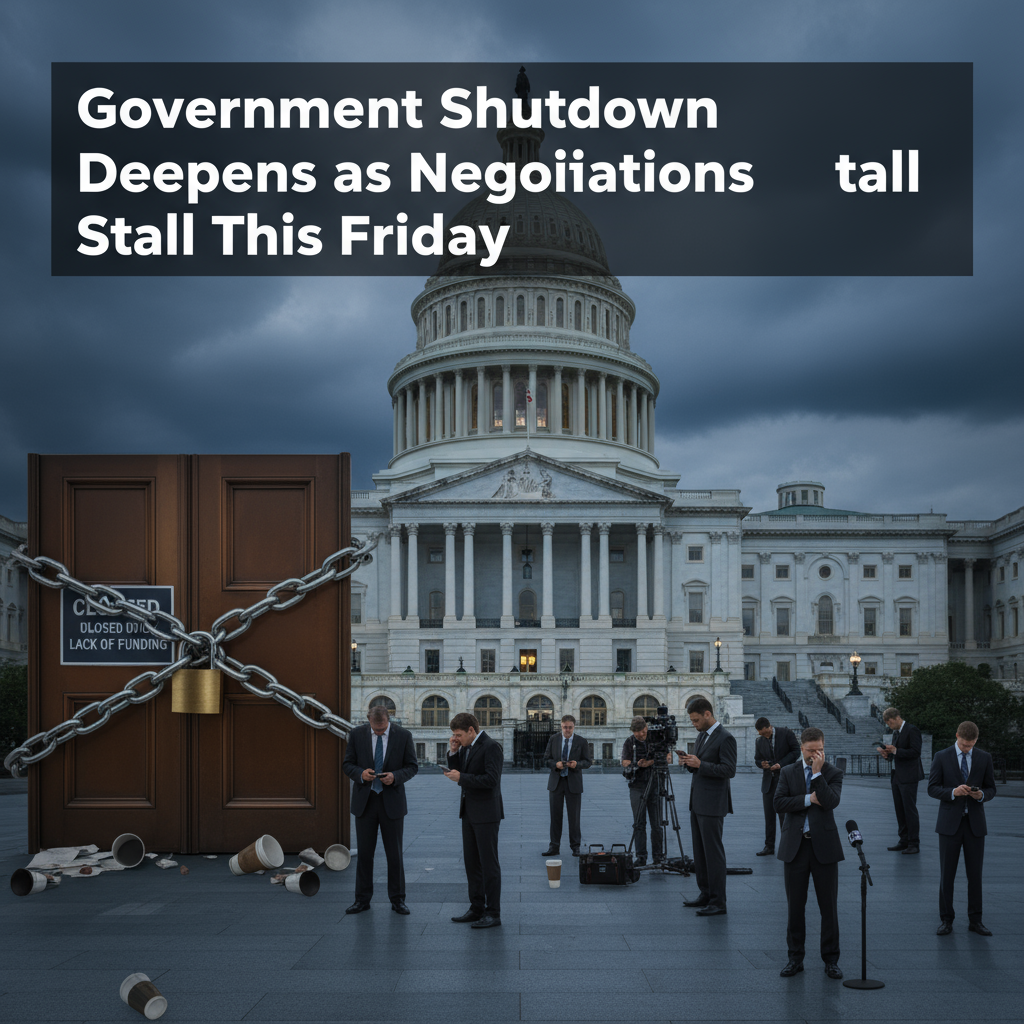Government Shutdown Deepens as Negotiations Stall This Friday
Estimated reading time: 6 minutes
- Shutdown Duration: The U.S. federal government has been shut down for four days, significantly impacting services.
- Stalled Negotiations: Congressional leaders and the White House are unable to reach a compromise over critical funding issues.
- Employee Impact: Approximately 800,000 federal workers are furloughed, while another 700,000 are working without pay.
- Service Disruptions: Essential services continue, but non-essential departments are facing slowdowns.
- Political Tensions: Rising political rhetoric as parties blame each other for the ongoing gridlock.
Table of Contents
- Stalled Negotiations: The Heart of the Issue
- Key Disputes
- The Scope of Impact
- Critical Consequences
- Political Positioning and Public Messaging
- Public and Institutional Impact
- Conclusion
Stalled Negotiations: The Heart of the Issue
The current impasse follows a series of meetings between Democratic and Republican congressional leaders and President Donald Trump. Unfortunately, these discussions failed to yield any compromise. The last significant meeting, which included Senate Majority Leader Chuck Schumer and House Minority Leader Hakeem Jeffries, ended without an agreement, prompting President Trump to cancel subsequent meetings with select Democratic leaders, labeling their demands as “unserious” (Wikipedia).
Negotiations have been marred by political gridlock within the Senate. Recent attempts to advance either party’s funding plan have failed. A proposed Democratic plan was rejected along party lines, while the Republican alternative, despite garnering some support from Democrats and independents, did not surpass the 60-vote filibuster threshold (CBS News).
Key Disputes
Several specific issues continue to divide the parties:
- Democratic Demands: Democrats are advocating for permanent extensions of Obamacare subsidies and reforms of previous Medicaid policies initiated by President Trump, as well as limitations on his authority to cut federal spending.
- Republican Position: Conversely, Republicans are pressing for a short-term funding bill, known as a Continuing Resolution (CR), which has already received House approval with some Democratic support. They insist that the bill proceed without major policy changes, committing to negotiation on these issues after funding is secured (Wikipedia).
Accusations abound from both parties, each blaming the other for holding essential government services hostage while trying to leverage unrelated policy outcomes (White House).
The Scope of Impact
The ongoing shutdown is significantly affecting federal employees and the services they provide. Approximately 800,000 federal workers have been furloughed, with an additional 700,000 continuing to work without pay (Wikipedia). Essential services, such as Medicare, Medicaid, TSA operations, and Amtrak, remain operational, albeit only at their essential capacity, while non-essential departments and agencies, such as the National Institutes of Health (NIH), the Centers for Disease Control and Prevention (CDC), and the Women, Infants, and Children (WIC) program, have faced significant operational slowdowns (Wikipedia).
Critical Consequences
Certain vital services are under threat:
- Military and Veterans Services: Pay for military personnel and crucial veterans’ services is at risk, which may lead to severe implications for those who have served the country (White House).
- Small Business and Disaster Relief Programs: Access to financial aid for small businesses and disaster relief may be hindered.
- Food Assistance Programs: Disruptions could critically affect food assistance for low-income families (White House).
- Visa Operations: While visa operations at U.S. embassies and consulates are currently sustained by application fees, ongoing shutdowns could result in delays or service suspensions (ISSS Emory).
The table below summarizes the immediate effects of the shutdown:
| Service/Agency | Status | Key Impact |
|---|---|---|
| Federal employees | 800,000 furloughed, 700,000 unpaid | Large-scale pay delays, workforce disruption |
| Medicare/Medicaid/TSA/Amtrak | Operational (essential only) | Non-critical functions slowed/stopped |
| NIH/CDC/WIC | Partial/full suspension | Research, public health, food aid affected |
| Visa/Consular Services | Mostly operational (for now) | Possible delays/suspensions if prolonged |
Political Positioning and Public Messaging
The political landscape is heating up as President Trump and Republican leaders assert that the Democrats are obstructing progress by demanding policy reversals that are not directly related to urgent funding questions. They argue that their proposed “clean” Continuing Resolution (CR) aligns with previous bipartisan agreements, highlighting their willingness to compromise on spending levels (White House).
Democrats, on the other hand, assert that expansions of critical social safety nets and legal reforms are non-negotiable issues that cannot be disentangled from discussions about funding, emphasizing the high stakes involved in their demands (Wikipedia).
The ongoing likelihood for resolution seems low unless Senate Democrats adjust their approach or some form of compromise is reached, given the numerous failed attempts to break the stalemate (CBS News).
In addition to the legislative impasse, political rhetoric has intensified, with aggressive public messaging on social media amplifying the urgency of the situation. This escalation comes as the public begins to feel the tangible impacts of this stalemate on essential services (Wikipedia).
Public and Institutional Impact
The ramifications of the shutdown extend beyond Washington D.C., with numerous advocacy groups expressing serious concerns about how service disruptions could disproportionately affect vulnerable populations, particularly seniors and veterans (White House). Universities and individuals, including international students, are being briefed about anticipated delays in essential services such as Social Security, Medicare, and immigration processes should the shutdown continue (ISSS Emory).
Conclusion
As the government shutdown persists and negotiations remain stalled, the repercussions on public services and the federal workforce continue to ripple outwards. With essential programs already feeling the strain and critical dialogues at an impasse, the situation signifies a complex web of political maneuvering, public impact, and the urgent call for resolution. As of now, the nation watches closely, awaiting a breakthrough in these negotiations that remains uncertain.
For more trending news, visit NotAIWorld.com.
FAQ
- What is the reason behind the government shutdown?
- How many employees are affected by the shutdown?
- Which services are still operational?
- What impacts does the shutdown have on the public?
